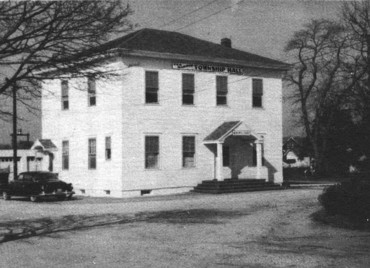 |
|
The Town Hall of Egg Harbor
Township, erected as a school
in 1873. The building is
on the west side of Bargaintown
Road in Bargaintown.
Photo
Hattie Anderson
|
|
|
Bargaintown (Cedar Bridge) in
Egg Harbor Township, 4 miles from Egg Harbor
Bay, contains 2 taverns, 1 store, a gristmill,
a Methodist Church, and about 30 dwellings
....(From Gordon's Gazetteer
of N. J. 1838.)
Anyone wishing to seriously study
the history of New Jersey will find the chapter
on "Original Land Grants of New Jersey"
in the "Early History of Atlantic County"
excellent reading. Briefly, the original grant
from King Charles II was East and West Jersey,
joined in 1637, to become New Jersey. West
Jersey contained Gloucester County of which
a portion was separated in 1837 to form Atlantic
County. Atlantic County contains Egg Harbor
Township, which contains Bargaintown.
From the "Judicial and Civil History
of New Jersey":
"Every foot of the soil claimed by
the original inhabitant (Lenni Lenape Indians)
of this State has been obtained from them
by a fair and voluntary purchase and transfer."
There is room for doubt as to the "fair
and voluntary" aspect of any land transactions
with the Indians. Certainly there is a lack
of psychological and anthropological understanding
of the Indians of this area in the following
conclusions, which appear in the "Lure
of Long Branch of New Jersey" by George
B. Somerville.
"The original Lenni Lenape was described
by the early writers as being almost lovable
in his hospitable simplicity, but when a
half century had given the white man's liquors
and the inter-mixture of bloods a chance
to show what they could do, it developed
that the red man was not what he once had
been; he was not possessed of the white
man's mental power to resist temptation
of over indulgence."
"The last act of the Lenni Lenape
drama or tragedy occurred when the New Jersey
Legislature appropriated $2000.00 in 1832
to extinguish all the right, title and interest
which the Lenni Lenape held or might hold
against the Colony or State."
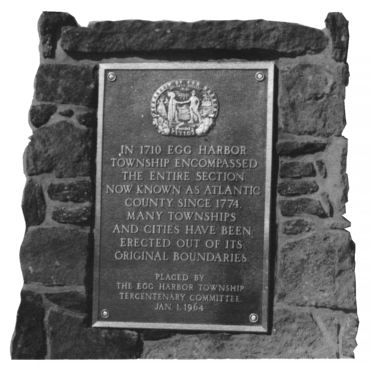 |
|
The monument and plaque
erected in front of the
Town Hall on Bargaintown
Road in Bargaintown.
Photo
Hattie Anderson
|
|
|
Mr. Somerville, his ancestors and all the
early settlers of New Jersey and Bargaintown
should give Thanks that the "lovingly
hospitable" Lenni Lenape chose to drink
the settlers liquor rather than lose their
good dispositions, don war paint and gone
forth to slit throats and collect scalps as
did their Apache neighbors to the North.
Whatever the justice or injustice of the
treatment of the Lenni Lenape, they were the
first residents of Bargaintown, making summer
camp on the high ground around the cedar swamp
that is now Bargaintown Lake and along the
banks of Patcong Creek. All of the South Jersey
Shore was used by the Lenape as a sort of
summer resort camp. They spent the season
digging for shellfish, picking wild berries,
hunting for bird eggs, catching and drying
fish and collecting those particular shells
for carving beads to be used as wampum. Arrowheads
in quantity have been found in Bargaintown
and if you don't mind a kink in the neck from
peering downwards, you have a good chance
of finding one. Indian pottery was also unearthed
along Patcong Creek. Wherever you walk in
this area, an Indian walked before you. Their
footpaths became our roads and their land,
our homes. There is no record of there ever
being a war-like incident toward the white
settlers by the Lenni Lenape Indians. It is
a nice thought that even in the beginning,
Bargaintown was a friendly place.
There were no famous Revolutionary battles
fought in Bargaintown, nor did any of her
men become well known heroes, but they served
with honor and as always, it is the unpublicized
ranks that fight a war and win it. Whatever
personal emotional stress and individual sacrifice
felt or endured by the early residents of
Bargaintown during the Revolution is lost
in time. Names that appear on the lists of
"Officers and Men of the Revolutionary
War, Gloucester County"; Somers, Smith,
Price, Ingersoll, Adams, English, Frambes,
Garwood, Ireland, Lake, Tilton, etc., appear
today on the mailboxes throughout Bargaintown.
If Bargaintown cannot claim a great Revolutionary
battle or hero - she can absolutely claim
that George Washington did not sleep here.
When and how Bargaintown received its name
depends on which version you choose to believe.
From the "History of Bargaintown"
(Unpublished) by William Lake, 1918.
"Tradition informs us that Bargaintown
received its name as early as 1760 by the
acts of one David Howell, a Blacksmith,
who had a shop at this place. He being the
owner of a number of acres of land in that
locality employed a surveyor to lay the
same off in tots, these lots were two perches
wide and four deep (or 33ft. by 66ft.).
He had a locust tree set out at the corner
of each lot, (who the surveyor was that
did the work I know not, as the old map
has neither name nor date marked upon it),
but it has plainly marked upon it the name
of Water Street and Second Street, each
street is 24ft. wide. It is said of Mr.
Howell that when any one came to his shop
to have any work done he labored as hard
to sell one of his lots as he did to do
the work, hence the name Bargaintown."
 |
| Gristmill built by Japhet
Ireland (d) (1776-1858). The
Mill some 30 feet west of
the one built by James Somers
(1695-1761), stood until recent
years. |
|
|
By far the most appealing and persistent
version of the origin of the name is that
of the bargain made between James Somers,
a large landholder, and his slaves. James
Somers lived on the East side of the swamp
that is now Bargaintown Lake and found it
both inconvenient and difficult for himself
and his associates to traverse to the West
side and vice versa. He offered freedom to
his slaves if in their spare time they would
build a road across the swamp. After performing
a full days work for their owner, the women
would carry sand and gravel in their aprons
or baskets and the men hand hauled stones
and timber, laboriously building a passable
road through the cedar swamp by lantern light.
When the road was completed, Mr. Somers true
to his word, granted the slaves their freedom
and a piece of land to till. The bargain successfully
accomplished, the village became known as
Bargaintown.
If the origin is obscure, the name is not.
BARGAINTOWN. It has both phonetic atmosphere
and character.
Though it cannot be proven that James Somers
was responsible for building of the road across
the swamp, which became Central Avenue, we
do know that he built the Grist Mill on Patcong
Creek side east of the dam and a Saw Mill
west of the dam. The Grist Mill that is pictured
and remembered today was the second gristmill
erected some thirty feet to the westward by
Japhet Ireland to replace the deteriorated
first mill building. The old grinding wheels
from the original mill were incorporated into
the masonry wall of the second mill. In 1918,Mr.
William Lake wrote this nostalgic paragraph
concerning the Grist Mill.
"The old grist mill still stands as
of yore but the grinding therein has nearly
ceased; here too, the old undershot wheel
and cogger have given way for the turbine
wheel and belts--the old stones that crushed
the grain, the bolt that bolted the fine
flour for the wedding cake at the marriage
bell have almost ceased to turn. The old
willow trees that stood by the side of the
pond, under which the farmer drove his horses
on a hot summer day whilst his grists were
being ground, have also passed away."
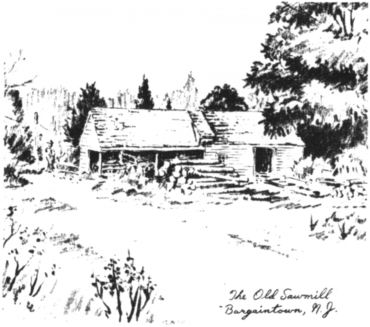 |
| The saw mill on the southerly
side of Central Avenue was
run by Daniel S. Collins in
recent years. |
|
|
Mr. Somers in his last will and testament
dated April 20th, 1758,bequeathed to his son,
James Somers, Jr., among other possessions,
the grist mill, saw mill and one acre of land,
purchased from Netum Babcock, adjoining the
saw mill property to be used as a log bank.
He also bequeathed an acre of land to the
(Quakers. This ground is across from Central
Methodist Church, Linwood, and is used as
a cemetery.
Concerning Netum Babcock from whom James
Somers purchased the one-acre of land for
a log bank, William Lake wrote,
"Netum Babcock was a seafaring man,
frequently making voyages to different parts
of the world. On one in the Mediterranean
Sea, in company with a number of other merchant
ships trading in that sea, they were attacked
by a number of pirate ships, a battle ensued.
Cap't. Babcock fought them to the last -
he was finally captured, his vessel robbed
by the pirates and them ran upon an island
where himself and crew were driven on shore.
The pirates decided that the man that had
fought them so bravely should not at once
lose his life; his right arm should be cut
off between the shoulder and elbow. After
this barbarous act was done the captain
was left to bleed to death. One of his sailors
seeing the condition his captain was in,
went on board their ship, got some pitch
and a kettle, brought them on shore, warmed
the pitch in the kettle and then had the
captain to plunge the stump of his arm in
warm pitch, which soon stopped the flow
of blood and by so doing saved the life
of Cap't. Babcock.
When I was a young man, one Mrs. Holdcroft,
an estimable old lady, and a daughter of
Colonel Doughty, frequently said to the
boys that met at her place to get cake and
beer; that when she was a young woman she
had frequently seen Cap't. Babcock with
his right arm off; as the Captain frequently
came to her father's place."
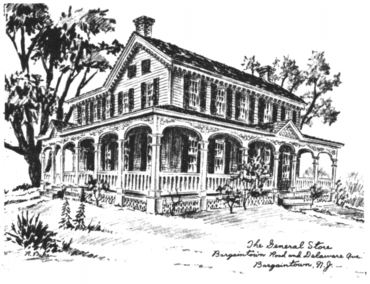 |
The General Store located
at the northwest intersection
of Delaware Avenue and Bargaintown
Road was operated by Somers
Edwin Leeds (1864-1959). He
married Aura the daughter
of Richard S. and Aimira (Babcock)
Garwood. He was a member of
the School Board and the Township
Committee.
..... from page 197 of the
Genealogy of the Lake Family
by Adams and Risley 1915.
Map  |
|
|
Mrs. Holdcroft's father, Colonel Doughty
was the genial host and proprietor of the
establishment known as Doughty's Tavern located
on what is now Delaware Avenue. Before the
building of the old Bargaintown School in
1873, the tavern was used as a town hall and
voting center for all of Egg Harbor Township.
Voting was practical and open. A moderator
and clerk were chosen. The moderator mounted
a wagon to address the assembled crowd. A
line was drawn in the dirt and ayes and nays
were counted by the voters stepping across
or remaining behind the line. Officers were
elected and monies voted for the expenses
of the Township. School taxes were levied
so much per child between the ages of five
and eighteen years. The number of sheep killed
by dogs during the year determined the amount
of dog tax. It is worth considering for a
moment that this method of handling government
affairs may be superior to the ponderous procedures
employed today.
In 1873, a school was constructed on Bargaintown
Road. Children from the ages of seven attended
from nine until four o'clock with all eight
classes being taught in one room by one teacher.
Township meetings were there after held in
the school instead of Doughty's Tavern, which
pleased David and Simon Lake. Township Officers
and temperate souls, who positively refused
to vote public monies for the purpose of purchasing
intoxicating liquors for the Township Officers
or anyone else attending Township meetings.
In 1914, a new brick school was built next
door and the old building renovated and renamed
Egg Harbor Township Hall, which is still the
center of Township government and voting.
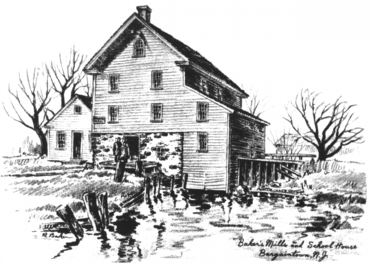 |
| Price's or Bakers Mill at
Pricetown on Patcong Creek
was built by John Price of
Mays Landing about 1757. The
Mill was operated at various
times by Richard Somers (?),
Daniel Baker, and Daniel E.
Benjamin and Edward Collins. |
|
|
Prior to-the Bargaintown Road School, an
earlier one-room schoolhouse existed on Mill
Road near the standpipe and is remembered
by William Lake.
"The old school house, where the boys
and girls learned their A.B.C.'s stood in
the edge of the woods on the west side of
the road that leads from the village of
Bargaintown to once Risley's Mills, where
now stands a water tower one hundred feet
high; this building stood near the head
of the Mill Pond. This building was 18 feet
in length, 16 feet in width and 9 feet posts;
it had 8 windows, three on each side and
one on each end; the eight were 8 by 10
inches. The writing desks were on the four
sides of the building, set against the wall;
in using these desks, the scholars always
sat facing the wall, with their backs to
the Master." "The room was heated
by a large tin plate stove set in the middle
of the room, a cord of wood stick four feet
long when cut in two made two sticks for
the stove. On three sides of the stove were
arranged three low benches without any backs,
for the small girls and boys to sit on.
On a cold morning the older ones always
crowded the smaller ones off. Well do I
remember the low bench on the boys' side.
It was made of an oak slab, in the same
condition it came from the saw mill, not
even the stub shot cut off."
The religious and social center of Bargaintown
was Blackman's Meeting House built in 1764
by the Presbyterian residents and the special
efforts of John Brainard, a patriot of the
Revolution. After 1789, the Methodists shared
the building and in 1814 purchased it. Needing
more space for a growing congregation, a brick
building was erected in 1822 close to the
original meetinghouse. $1525.95 was pledged
to the building fund, which seems ridiculously
low, but so were the invoices tendered:
| |
Digging
well 18ft. deep |
$
|
6.50
|
| |
Laying
54,050 brick |
|
135.12
1/2
|
| |
Painting
and glazing 364 lights |
|
18.00
|
| |
Two
bundles of lath |
|
.20
|
| |
3355
feet of frame stull |
|
31.87
|
| |
500
feet of 5/8 cedar boards |
|
7.50
|
| |
Carting
13,600 brick |
|
8.50
|
| |
Two
days work painting |
|
1.50
|
|
 |
Zion Meeting
House, Bargaintown, 1963
Photo
by Joseph Henry Bennett |
|
|
Zion Methodist Meeting House continues to
serve its congregation, which again threatens
to out-grow it.
It is not surprising that many of the men
at rest in the old graveyard of Zion Church
were of the sea, since three shipyards were
active on Patcong Creek. Two and three masted
ships were built, one of them the AIDE, three
hundred and fifty tons, built in 1854. William
Lake remembers:
"Anyone looking at the remains of
the old saw mill and stream at the present
day would say it looks very much like a
fairy story to say that one day they built
vessels by the side of this old mill site.
Job Ireland, the old sawyer, frequently
told us boys, that he had sawed deck plank
in the mill and shoved them from the saw
to the deck of the vessel. Sad was the day
to the old sawyer, when a vessel named the
"Miller" was launched from this
yard - as she slid off the ways she listed
to one side, one of his sons being on board
fell down the mast-hold and was killed.
The second shipyard, known as early as 1803,
in after years at Jole's Landing, is about
one-eighth of a mile below the mill. In
building a vessel at this yard, the adjoining
landholders got into a dispute as to the
correct location of their partition line.
A surveyor was called upon to locate the
line; it was found that the line crossed
the keel of the vessel. To adjust the matter
the keel had to be moved some 15 or 20 feet
to the southwest.
The third yard was about one-fourth of
a mile below the sawmill and is known at
this day 1918, as the old shipyard. The
dock in which the vessels were launched,
can be plainly seen at this date and very
plainly marks the historical spot.
Nicholas Frambush (Frambes) was the owner
of this yard, with the assistance of his
three sons, namely, Job, David and Andrew
and his son-in-law, Daniel Edwards, a blacksmith.
They always had a vessel on the stocks.
In the winter of 1856-7 I was in New York
keeping ship, our vessel having been frozen
up and navigation almost at a standstill.
Here I became acquainted with an old sailor,
by the name of John Lee from English Creek,
who informed me that he had made a voyage
from New York to the West Indies in a Brig
built at Bargaintown."
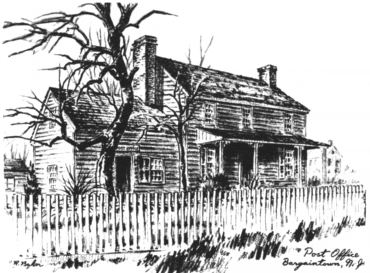 |
| The first Postmaster of
Bargaintown was Samuel Somers
in 1807. In 1872 the postmaster
may have been J.I. Frambes,
as the post office is shown
at his house located at the
southeast corner of Central
Avenue and Water Street. **
Sometime after this post
office was in the house
across the street, pictured
above. This office was ended.
The house is now owned by
Francis Sutton:
** Area
Map I  & Area
Map II
& Area
Map II  of Bargaintown; Map of Atlantic
County, Bargaintown inset,
by Beers, Comstock and Cline,
1872.
of Bargaintown; Map of Atlantic
County, Bargaintown inset,
by Beers, Comstock and Cline,
1872.
|
|
|
Bargaintown's blacksmith shop was built by
David Howell and was located on the west corner
of Water Street and Central Avenue on property
that is now owned by Mr. Francis Sutton. Daniel
Edwards, Nicholas Frambes's son-in-law, served
his apprenticeship under David Howell, eventually
becoming owner. Business increased until the
old shop was torn down and a larger one built
on the same site containing two forges. Enoch
Ingersoll became owner after serving his apprenticeship
and 1834 conveyed ownership to Mark Lake.
These men over the years kept the shipyards
on Patcong Creek and various others on Atlantic
and Cape May Counties supplied with iron fittings.
The making and repairing of carpenter tools,
farming implements, nails, horseshoes, etc.,
made the blacksmith shop indispensable to
the progress and convenience of the Community.
Besides the grist mill, saw mill, blacksmith
shop, shipyards, church, schools, tavern,
plantations and residences, the village of
Bargaintown boasted a shoe shop, general store,
post office, custom house and an ice business.
The general store stood some three hundred
feet from Cedar Bridge off Zion Road where
the present day home of Mr. and Mrs. E. W.
Lister is located.
The post office was established in 1807,
with Samuel Somers as the first Postmaster.
The last Post Office was located on Water
Street and still stands as the residence of
Mr. Francis Sutton and his daughter and son-in-law,
Mr. and Mrs. David Clayton. Mail was picked
up and delivered by stagecoach. Bargaintown
was also a main stagecoach stop on the route
to John Knisell's ferry in Camden.

Click on photo for larger
view.  |
|
Shown in the picture are
Joseph Thoman, Joshua Tindley,
Hosea Sutton, Frank Hackett,
Herman Shauffer, Robert
Lloyd, Joseph Price, sitting
on the cake of ice; John
Doughty, Joshua Garwood,
Ben Sutton, Fred Myers,
Joshua Dueble, William Bird,
Smith Sutton and Gus Brower.
The men are holding saws,
and other implements necessary
to their trade.
The ice cutting industry
flourished until about 1918.
Richard F. Collins and Dardel
S. Collins, brothers, were
the main "ice men".
Richard Collinm had his
icehouse on Mill Rd. near
the old stand pipe while
Dardel S. Collins had ice
houses on Central Ave. (the
Mill pond) and in Somers
Point.
Original
photograph from Mrs. James
Way A copy by Jack E. Boucher
|

Click
on Certificate above to
see larger version. 
|
| A photocopy of the Commission
to Robert B. Risley appointing
him, Collector of the Customs
for the District of Great
Egg Harbor and Inspector of
the Revenue for the Port of
Bargaintown in the State of
New Jersey.
Copy
of the original Commission
by Joseph H. Bennett
|
|
|
In the late 1800's, Daniel S. Collins ran
a prosperous ice business with storage buildings
at both ends of Bargaintown Lake. A narrow
canal was cut through the ice the length of
the lake. Cakes of ice were hand cut and floated
with the aid of hooked poles along the canal
to either building where they were stacked
and covered with sawdust to await the summer
demand.
The Custom House stood on the lake side of
Central Avenue on property that is now owned
by Mr. and Mrs. John H. Dilks and was enacted
into being by a document dated the 8th day'
of February, 1845, and signed on the 12th
day of February, 1845, by John Tyler, President
of the United States and George M. Bibb, Secretary
of the Treasury, appointing Robert B. Risley
Collector of the customs for the District
of Great Egg Harbor and Inspector of the Revenue
for the Port of Bargaintown on the State of
New Jersey. This remarkable document is owned
by Mrs. Marie Cavileer Gandy of Linwood, New
Jersey and is in perfect condition including
the metal tube in which it was originally
delivered.
The natural assets of Patcong Creek and the
old cedar swamp must be credited for the prosperity
of the early Village of Bargaintown. Damming
the creek provided timber for the building
of homes, businesses and ships. If you enjoy
a relaxing, spellbound hour, pick a calm,
sunny day in early spring or late fall when
the water is cold and clear. Beg, borrow or
rent a boat and row out upon Bargaintown Lake.
Wear sunglasses to dissipate the sun's glare
on the water surface and the visual effect
is the same as a glass bottomed boat. You
cannot help but be fascinated by the skeletal
remains of the once spectacular stand of grandiose
cedar trees. Water worn and eerie in their
shapes and unusual positions, huge stumps,
logs and branches populate the lake bottom.
Many stumps are three to five feet across.
Stripped tree tops twenty to thirty feet long
and a foot to two feet across lay where they
were discarded. Branches twine in tangled
confusion. The entire lake is a watery graveyard
for a butchered forest primeval. There is
nothing from the past I would have rather
seen than these straight, towering cedar giants.
Trees of size and dimension such as will never
be seen in this area again. The scene will
haunt you.
I have quoted liberally from William Lake's
recollective sketch of Bargaintown because
I thought it to be the most interesting and
charming material written about Bargaintown.
Mr. Lake was approximately eighty years old
when he wrote it and it is a combination of
fact and nostalgia. He is repeatedly concerned
about the future of Bargaintown.
"I alone am left to tell the story
of more than seventy years ago. Who? Who
will tell the story of seventy years hence?"
"The Post Office at Bargaintown has
been stricken from the list of Post Offices
in the Department at Washington, ID. C.,
the name will soon be forgotten; death and
decay are written on all of the old shipyards,
mills, blacksmith's shop, shoe shop, store's
and tavern."
Mr. Lake need not have worried. There are
new enterprises, improvements and progress
of which Mr. Lake could not have imagined.
The descendents of the early families still
contribute their talents to Bargaintown, attend
its schools and churches, plus all the others
that have come to build their homes and live
here. Old buildings decay and disappear. The
continual waves of progressive change transform
the landscape, but the people are the essential
ingredient to the future of the locale. We
are the living future that Mr. Lake was so
needlessly concerned about in 1918, and our
children and their children after them secure
the coming future of Bargaintown. History
is a record of the activities and accomplishments
of people. It has no ending.
Beryl D. Mason
|











